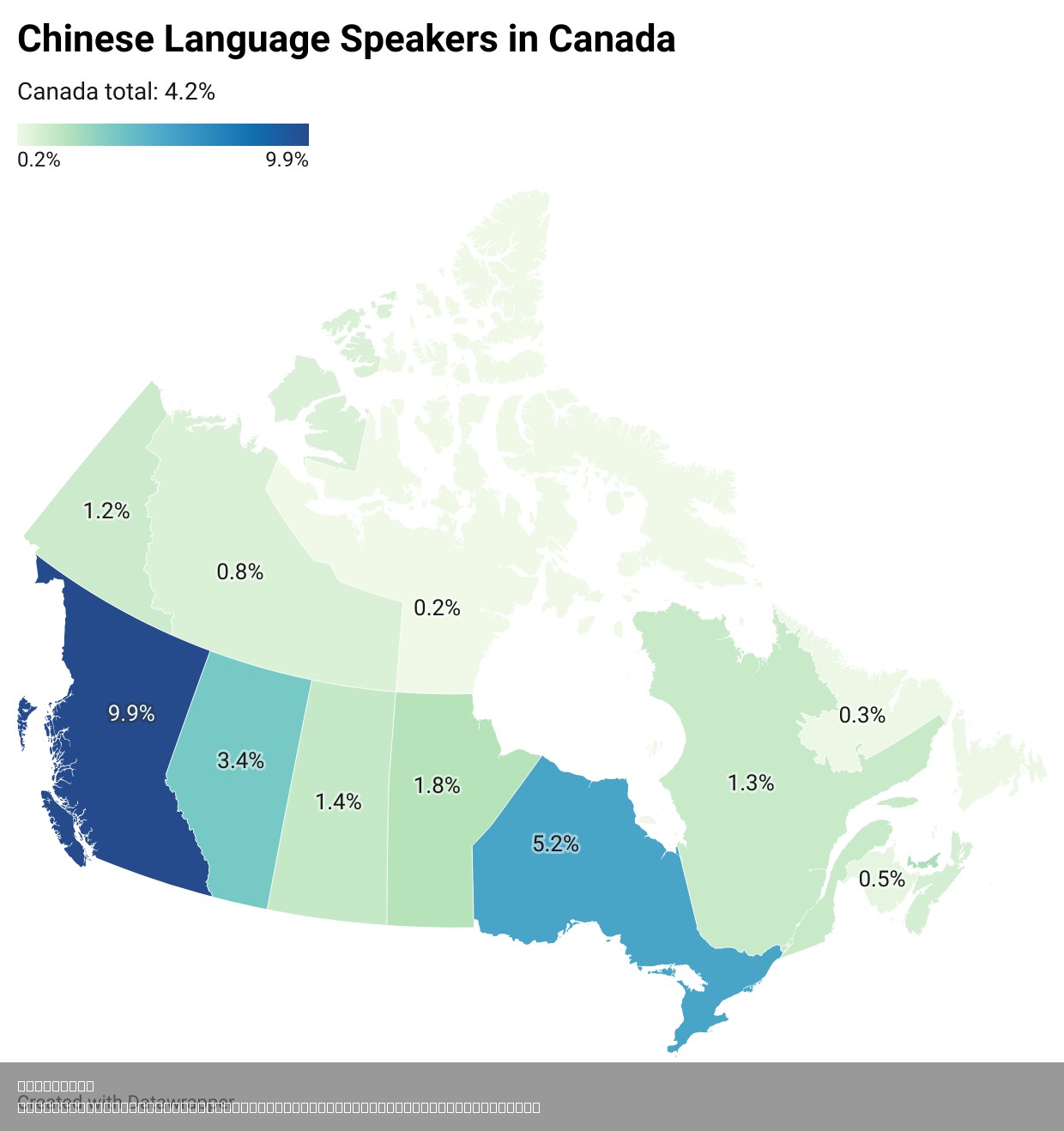Chinese Language Speakers per Canadian Province and Territory Map


David Chen
Data Visualization Specialist
David Chen is an expert in transforming complex geographic datasets into compelling visual narratives. He combines his background in computer science ...
Geographic Analysis
What This Map Shows\nThis map vividly displays the distribution of Chinese language speakers across the various provinces and territories of Canada, based on data from the 2021 Census. With a significant number of residents identifying Chinese as their mother tongue or preferred language, this visualization highlights not only where Chinese communities are concentrated but also provides insight into the cultural diversity woven into the Canadian fabric. Canada's multicultural policy has encouraged immigration from diverse regions, particularly from China, leading to a notable increase in Chinese speakers throughout the country.
Deep Dive into Chinese Language in Canada\nChinese is one of the most widely spoken languages in Canada, ranking among the top languages following English and French. The Chinese language encompasses various dialects, including Mandarin and Cantonese, and serves as a primary language for many immigrants from China, Hong Kong, and Taiwan. According to the 2021 Census, over 1.7 million Canadians reported Chinese as their mother tongue, a figure that reflects the growing significance of Chinese-speaking communities in urban centers and beyond.
Interestingly, the Chinese language’s prominence is not just a reflection of population numbers but also of cultural integration and contribution. Cities like Vancouver and Toronto have seen vibrant Chinatowns, bustling with businesses, cultural festivals, and community gatherings that celebrate Chinese heritage. These areas have become critical hubs for Chinese speakers, providing them with resources and support while enhancing the multicultural landscape of Canada.
The data from the 2021 Census reveals that the majority of Chinese speakers reside in urban areas. For instance, British Columbia, particularly Greater Vancouver, boasts the highest concentration of Chinese language speakers, where almost 20% of the population speaks Chinese. In Ontario, particularly in the Greater Toronto Area, the numbers are similarly high, showcasing how these urban centers are magnets for Chinese immigrants seeking opportunities and community.
Moreover, the growth of Chinese language speakers in Canada is indicative of broader social trends. As China’s global influence continues to expand, the importance of the Chinese language is becoming increasingly recognized. Educational institutions across Canada are responding by offering more programs in Mandarin, reflecting a growing interest in Chinese culture and language among non-Chinese speakers as well.
Regional Analysis\nWhen examining the map in detail, British Columbia stands out with a significant percentage of its population speaking Chinese languages. The metropolitan area of Vancouver is home to a thriving Chinese community, with Mandarin and Cantonese being the most commonly spoken dialects. In contrast, Alberta and Manitoba also have notable Chinese-speaking populations but at lower percentages compared to British Columbia.
Ontario is another key region, especially in cities like Toronto, where the Chinese-speaking population is diverse, comprising speakers of various Chinese dialects due to immigration from different regions. Interestingly, the numbers in Quebec are lower, which could be attributed to the province's unique linguistic landscape dominated by French. However, Montreal does have a growing Chinese community, reflecting broader immigration trends.
In the Atlantic provinces, the Chinese-speaking population is smaller, which could indicate lower immigration rates from Chinese-majority countries historically. Nevertheless, cities like Halifax are beginning to see an increase in diversity, including Chinese speakers, as more immigrants settle in search of opportunities.
Significance and Impact\nUnderstanding the distribution of Chinese language speakers in Canada is crucial for several reasons. First, it sheds light on the country's demographic changes and the increasing diversity that shapes Canadian identity. Furthermore, this map can help policymakers and businesses identify community needs, from language services to educational programs, ensuring that all Canadians have access to resources that reflect their cultural backgrounds.
Moreover, the rise of Chinese language speakers has implications for Canada’s international relations and trade, especially as Canada seeks to strengthen ties with China. Language is a key component of cultural exchange, and by recognizing and supporting Chinese-speaking communities, Canada can foster better communication and collaboration on various fronts.
Looking forward, projections indicate that the number of Chinese speakers in Canada will continue to rise, particularly as immigration policies adapt to global movements. This growth will likely enhance the multicultural tapestry of Canada, making it essential for society to embrace and celebrate this linguistic diversity.
In conclusion, the map of Chinese language speakers across Canada is not just a representation of numbers; it's a reflection of the vibrant communities that contribute to the nation's identity. As Canada continues to evolve, understanding these dynamics will be crucial in shaping a more inclusive society for all its residents.
Visualization Details
- Published
- August 5, 2025
- Views
- 170
Comments
Loading comments...